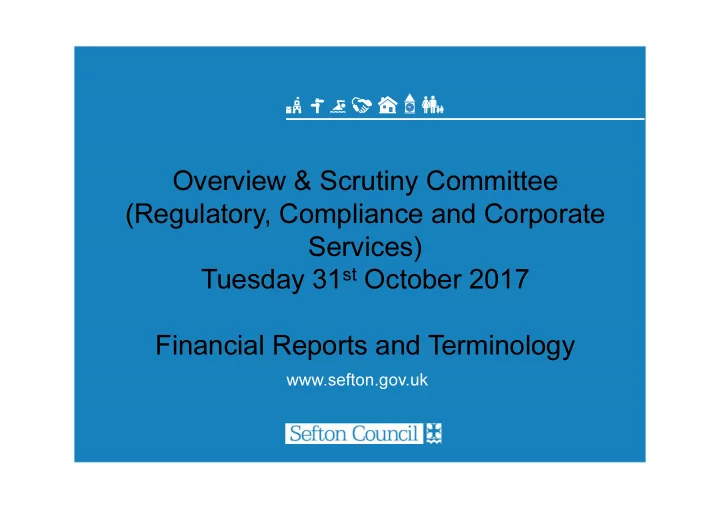

Overview & Scrutiny Committee (Regulatory, Compliance and Corporate Services) Tuesday 31 st October 2017 Financial Reports and Terminology www.sefton.gov.uk
Areas to be covered • Best Practice in Financial Management • The annual reporting cycle • How Members engage • Aims of Financial Reporting • Key Aspects
Best Practice Financial Management Three key elements of financial management: • Enabling Transformation • Supporting Performance • Delivering Accountability Financial Reporting is a key part of each of these and enables informed decisions to be reached
Chief Financial Officer • Chief Financial Officer (Head of Corporate Resources) has responsibility for “ making arrangements for the administration of the Council’s financial affairs ” • Includes ensuring budgets are robust, the Council has adequate reserves, effective controls are in place and value for money is achieved
Financial Reporting cycle MTFP Update continually Outturn Budget Reporting Reporting (June-July) (Feb/March) Budget Monitoring Scrutiny Reporting (June- March)
Key bodies Member Officer Cabinet Departmental Management Teams Council Strategic Leadership Board Overview and Scrutiny Committee Executive Leadership Team Audit and Governance Committee
Distinctions-Revenue or Capital (1) Revenue – transactions relating to the day to day running of Council services • Expenditure is funded from Government Grants, Council Tax, Business Rates and Fees & Charges • Link to Capital Expenditure as Revenue includes the cost of borrowing and other revenue consequences of capital expenditure decisions
Distinctions-Revenue or Capital (2) Capital – transactions relating to investing in buildings, infrastructure and expensive pieces of equipment • Mainly buying, constructing or improving physical assets (e.g. Buildings, Land and Vehicles, Plant & Equipment) • Funded by Borrowing, Grants & Contributions, Capital Receipts and Revenue Resources • Must have a life of more than one year
Revenue Process (1) • Update the Medium Term Financial Plan – normally covering 3 years – to identify forecast budget gaps (April – June) • Formulate options that could mitigate budget gaps – links to Council’s Core Purpose, Framework for Change, etc. (Typically July – October) • Members consider options and a budget package is developed (November – March)
Revenue Process (2) • Budget Council agrees the annual budget for the following year and level of Council Tax (and possibly budget plans for future years) (late February / early March) • Budget formally monitored throughout year – monthly starting in June – considered by the Executive Leadership Team, Strategic Leadership Board, Cabinet and Overview & Scrutiny
Aims of Financial reporting What are we seeking to achieve? What have we What decisions do done so far? Eg we need to make? what have we spent/delivered What do we think What conclusions we are going to have we reached? do? Eg.What do we think we will spend
Capital Process • Capital Strategy agreed by Budget Council • Links to Council’s Framework for Change eg Public Sector Reform, Strategic Investment and Economic Growth • Schemes and associated funding are approved by Council and / or Cabinet for inclusion in the Capital Programme
Capital Programme Budget Monitoring • Capital Programme is multi-year rather than just annual • Total scheme forecast variations important as capital resources limited so remedial action will be required to ensure scheme is funded or funding can be released at an early stage • Annual forecast variations also important as delays in expenditure ties up limited capital resources that could be used on other schemes
Council Tax • Council Tax Requirement set for the year (based on Council Tax level agreed and the Council Tax Base). • This will paid from the Collection Fund (the statutory account for recording Council Tax and Business Rates income) and is fixed regardless of the amounts collected. • Any surplus or deficit due to the amounts collected in the year will be accounted for in the following year.
Business Rates • Business Rates income is set for the year (based on the NNDR1 form submitted to the DCLG showing forecast income). • This will paid from the Collection Fund and is fixed regardless of the amounts collected. • Any surplus or deficit due to the amounts collected in the year will be accounted for in the following year.
Council Tax / Business Rates • These income streams more important than ever as they make up an increasing percentage of our funding. • As part of the Liverpool City Region Business Rates Retention Pilot we now keep 99% of Business Rates income. • Forecasting Business Rates difficult due to outstanding appeals that can take years to resolve (and will be backdated)
Questions?
Recommend
More recommend